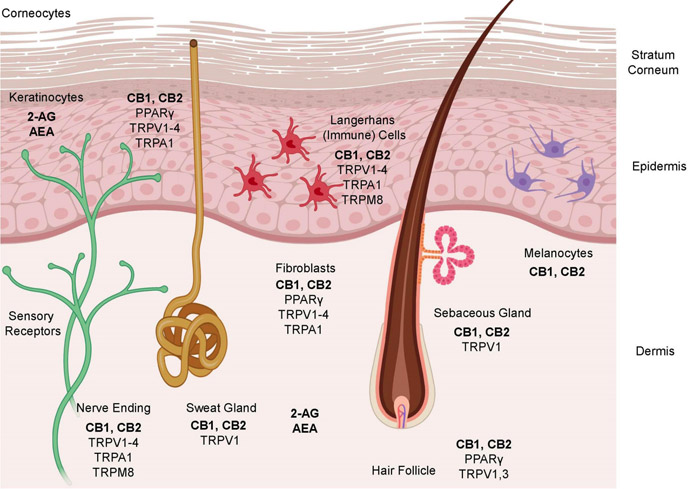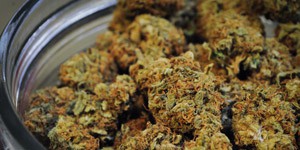By Tanja Bagar

Dr. Tanja Bagar is a microbiologist with a PhD in Biomedicine. She has gained extensive research experience in biotechnology, molecular biology and cell signaling in laboratories in Slovenia, Germany and the UK. Her focus has mainly been on the endocannabinoid system and active substances from cannabis/hemp. Her work led to the formation of the International Institute for Cannabinoids (ICANNA), where she is the CEO and chairman of the Expert Council. She is also the deputy director and head of R&D in an environmental company. She is active in the academic sphere as well. She lectures on microbiology and is the dean of the master’s program of Ecoremediations at the Faculty Alma Mater Europaea.
Our skin is the largest organ in our body; in an adult person it covers about 2 square meters and weighs about 3.5 kilos. Besides being the outermost layer of our body, it has many vital functions. Without the excellent protective barrier function of the skin, our insides would literally evaporate.
The skin has so many functions and is involved in so many organ systems that, instead of just being our surface layer, we can more accurately think of it as being connected to each part of our body. It functions as a waterproof, insulating shield, and enables the body to maintain internal homeostasis even in extreme temperatures, strong sunlight, and harsh wind. Our skin is also a part of the immune system we are born with, and not just a physical barrier: it exudes antibacterial substances that prevent pathogens from infecting us, and is covered in beneficial bacteria that do many amazing things, including the production of vitamin D. We can also think of our skin as a part of our nervous system, since each square millimeter is packed with nerve cells that function as a vast sensor for all the various stimuli coming from the environment and send these messages to the brain.
Our skin is not just a layer but is actually composed of three layers: epidermis, dermis, and subcutis. The outermost layer is called the epidermis, and it consists mainly of cells called keratinocytes (containing a lot of the protein keratin). Keratinocytes form several layers that constantly grow outwards as the exterior cells die and flake off. It takes roughly five weeks for newly created cells to work their way to the surface. Even this outermost layer of the skin is equipped with immune functions, since it harbors Langerhans cells, which alert the immune system to viruses, allergens, and other possible threats. The dermis is the middle layer of the skin and gives it strength and elasticity thanks to collagen and elastin fibers. Blood vessels here help regulate body temperature by increasing blood flow to the skin to allow heat to escape, or by restricting the flow when it's cold. This layer is highly populated with neurons, and the many nerve fibers and receptors pick up feelings such as touch, temperature, and pain, relaying them to the brain. The dermis is also the layer where hair follicles and glands are located. The innermost layer of the skin is the subcutis, which is mostly composed of fat cells and connective tissue. Most of your body fat is stored here. The subcutaneous layer acts as insulation to protect your internal organs and muscles from shock and changes in temperature.
Another very important and often overlooked function of the skin is its capacity for absorption. Several studies have shown that the skin can absorb various chemicals that it encounters and transport them into our blood stream. In fact, we should look at all the substances that our skin touches as edibles. All of our skin is highly permeable, but face skin is several times more permeable, and underarms and genitalia have an absorption rate of 100%. One study, for example, investigated the skin's absorption rates of chemicals found in drinking water. It showed that the skin absorbed an average of 64% of total contaminants found in water. Other studies showed 100% skin absorption for fragrance ingredients. This really underlines the importance of the choices we make for products that encounter our skin or that we put on our skin.
The endocannabinoid system of the skin
We know that the endocannabinoid system plays a vital role in the homeostasis of the body, and recently much research data shows that it is also critically involved in the health of the skin by maintaining its homeostasis and barrier function: its dysregulation has been implicated in various skin disorders. All the elements of the ECS are present in the skin layers. Of all the endocannabinoids, anandamide (N-arachidonoyl ethanolamide, AEA) and 2-arachidonoyl glycerol (2-AG) are the best studied in the skin and have been found in keratinocytes and fibroblasts. Other less known endocannabinoids like N-palmitoyl ethanolamide (PEA), N-alpha-linolenoyl ethanolamide (ALEA) N-linoleoyl ethanolamide (LEA), N-oleoyl ethanolamide (OEA), N-stearoyl ethanolamide (SEA), N-eicosapentaenoyl ethanolamide (EPEA), N-docosahexaenoyl ethanolamide (DHEA) have also been detected in the skin. The enzymes that synthetize and degrade endocannabinoids, such as DAGL, FAAH, and MAGL are also present in various types of skin cells.
In addition, both CB1 and CB2 cannabinoid receptors are found in epidermal keratinocytes, cutaneous nerve fibers, dermal cells, melanocytes, eccrine sweat glands, and hair follicles. Other receptors that are also a part of the wider ECS, the endocannabinoidome, are vital in skin health, such as TRP and PPAR receptors. The activation of these receptors is involved in many different functions like the formation and maintenance of the skin barrier, cell growth, cell differentiation, and immunological, neurological, and inflammatory processes.

Figure 1: Schematic representation of the key components of the ECS in different cellular compartments of the skin (Baswan et al., 2020)
What can phytocannabinoids do for your skin?
A properly functioning ECS is vital for the complete health of our body and mind, including our skin. The dysregulation or disfunction of the skin's ECS has been linked to several skin conditions, such as atopic dermatitis, itch, acne, psoriasis, hair growth/loss, hyper/hypopigmentation and many more. Due to the important regulatory function the ECS has in the skin, the use of topical cannabinoids has been considered for certain disorders and skin health in general. The potential of the topical use of cannabidiol or CBD is the best studied.
CBD is not an easy molecule to get into the layers of the skin: it has a molecular weight of 314.46 Da and a high log P value (lipid/water partitioning) of ~6.3. Therefore, using CBD via transdermal delivery comes with some challenges. To overcome these, it is very important to use appropriate carrier systems and penetrators (terpenes). Ethosomal carriers and hydroalcoholic gels have been proven to be efficient for the successful transdermal delivery of CBD. Many diverse substances have been used as skin penetration enhancers. You may find the following in your cosmetic cupboard: sulphoxides, pyrrolidones, urea, ethanol, 2-propanol, caprylic alcohol, propyleneglycol, glycerol and many others. Plant terpenes (most abundantly found in essential oils) are efficient enhancers to promote the percutaneous absorption of several substances in a topical formulation into the lower skin layers. Terpenes (including the ones found in cannabis) effectively facilitate the permeation of both hydrophilic and lipophilic substances, such as cannabinoids, so they should be incorporated into cannabinoid-containing topical products.
Since skin is exposed to many environmental factors/stressors, it is also subjected to the generation of a lot of reactive oxygen species (ROS) which are involved in several skin disorders and skin aging. Healthy skin has numerous defense mechanisms to catch and neutralize the ROS, since oxidative stress can induce cell damage. There are two master regulators of the cellular antioxidant defense system: NRF2 (nuclear factor erythroid 2-like 2) and PPAR-γ. CBD has been shown to induce the expression of HMOX1, the stress-induced enzyme hemeoxygenase1 (HMOX1) that is one of the key NRF2 target genes and exhibits antioxidant and anti-inflammatory properties. CBD was also shown to penetrate the skin cells and balance the oxidative stress response resulting from UVB irradiation and was effective in helping to protect the membrane integrity of skin cells. CBD can also activate PPAR-γ with a corresponding decrease in levels of NFkB. Both the HMOX1 enzyme and the PPAR-γ receptor have strong cytoprotective roles, with anti-inflammatory, antioxidant, and antiapoptotic properties. Treatments regulating their expression could be beneficial for skin conditions characterized by inflammation and keratin disorders, such as atopic dermatitis.
The ability of the skin to heal from damage is also vital and can become disrupted in a number of skin diseases. Tissue damage typically triggers an inflammatory response that results in swelling, pain, irritation, and sensitization of peripheral tissues and, if not resolved, it can lead to chronic pain and wounds. Wound healing is an intricate process which includes three overlapping phases – inflammation, proliferation, and maturation/tissue remodeling. The complex process of wound healing is influenced by the ECS, which especially modulates epidermal proliferation and differentiation and cutaneous inflammation. Phytocannabinoids produce their effects in wound healing via multiple mechanisms such as activation of CB1 and/or CB2 receptors, upregulation of anti-inflammatory factors, indirect activation of TRPV1 and epidermal growth factor receptors, and inhibition of the FAAH enzyme. There are a few studies that look at wound healing and the topical use of cannabinoids in particular: one study looked at patients with Epidermolysis bullosa (a rare skin disorder characterized by pain and blistering) and found that patients that used topical CBD experienced faster wound healing, less blistering, and reduction of pain. Research showed that topical use of cannabis extracts standardized to 5% CBD treatment resulted in upregulated expression of 26 genes involved in inflammatory pathways and included chemokines like CXCL8 and CXCL10, interleukins like IL−17C and IL−1B, and VEGF-A in human keratinocytes and fibroblast cells. In these same cells the cannabis extract regulated the expression of genes involved in wound healing, inflammation, and matrix remodeling: CBD alone produces some effects on gene expression but not as potently as standardized extracts.
Atopic Dermatitis (AD) is a one of the most common skin disorders. It is characterized by chronic skin inflammation that can have multiple causes, such as environmental triggers, damaged skin barrier function, microbiome imbalance, genetic predisposition, and an altered immune response. Phytocannabinoids have been shown to be able to modulate more than one underlying mechanism. CBD was shown to exhibit anti-inflammatory and immunomodulatory properties and can downregulate the FAAH enzyme (degrades anandamide) and thereby reduce itching. Skin microbiome imbalance is also very important in AD; in particular, overgrowth of Staphylococcus aureus (S. aureus) and formation of biofilms can significantly contribute towards the severity of dermatitis. The antimicrobial and antibiofilm activity of cannabinoids and terpenes such as myrcene, αpinene, and β-caryophyllene show great potential for restoring the skin microbiome and contributing to healthy skin.
Acne is another skin condition that a lot of people experience, with an incidence of approximately 85% between the ages of 12 and 24. The main factors involved in acne onset are sebum overproduction, unwanted sebocyte proliferation, bacterial overgrowth, and inflammation. The ECS is involved in many aspects of healthy skin, including lipogenesis. Anandamide, for example, has been shown to stimulate lipid production in human sebocytes at low concentrations, but induces apoptosis at higher levels. Several in-vitro studies point to the potential of CBD as a novel therapeutic option in people with acne by acting on pathways relating to sebum production, sebocyte proliferation, and inflammation. CBD has a regulatory effect on the function of sebaceous glands and reduces excessive lipid synthesis in a dose-dependent manner. The anti-proliferation abilities of CBD were also shown to be effective in skin with excessive sebocyte proliferation. CBD did not suppress cell counts beyond the starting number but did significantly reduce overall sebocyte proliferation. The anti-inflammatory effect of CBD is also essential against acne, and research found that CBD was able to prevent pro-acne mediators like TNF-α, IL−1B and IL6. As is the case with AD, the microbiome is also a huge contributory factor with acne imbalance in the skin. The bacterium Cutibacterium (formerly known as Propionibacterium) acnes (C. acnes) is very commonly connected with acne, and C. acnes overgrowth is linked to the severity of acne. A whole plant extract of hemp was tested for its antimicrobial effects on C. acnes and showed excellent antimicrobial effects on this bacterium. As well as cannabinoids, whole plant extracts also contain many terpenes which were shown to have an anti-microbial effect against C. acnes. The anti-lipogenic, anti-proliferative, anti-inflammatory, and anti-microbial properties of phytocannabinoids make them excellent candidates for treating acne.
Conclusions
Skin is an amazing organ: it is an airtight, watertight, and flexible barrier between the outside world and our inner biochemistry. The importance of the ECS in maintaining the proper function of our skin cannot be understated. The homeostasis of the skin is maintained by a properly functioning ECS, and many dermatological conditions are linked to a disfunction of the ECS. The topical use of cannabinoids holds much promise for many skin disorders, such as atopic dermatitis, acne, and wound healing, and many other symptoms, such as swelling, pain, and itch. Cannabinoids, with their vast array of beneficial effects, ranging from anti-oxidative, anti-inflammatory, anti-microbial, anti-lipogenic, anti-proliferative to immunomodulatory and neuroprotective, can be of great benefit to the health of our skin and its ability to maintain a healthy barrier function. Although a great deal of research has already been done, much remains to be discovered about the complexity of the interactions of cannabinoids with skin layers and other systems in the body. Cannabinoids are very safe substances and are well tolerated when used topically and orally. They also contribute significantly to how we feel and how well we cope with stress, thus adding another important aspect to healthy- and attractive-looking skin. Not to mention that cannabinoids are one of the rare true anti-aging molecules, as they slow down the enzyme telomerase, which shortens telomeres. Telomeres are the cap ends of chromosomes, and work like biological clocks. With each cell division, a part of the telomere is lost, so it shortens with aging. When they get too short, the chromosomes can no longer divide and the cell dies, so the length of the telomeres determines our cellular-biological age. Many anti-age approaches, even gene therapies, target the telomerase enzyme that shortens these telomeres. With cannabinoids slowing down this enzyme, they contribute significantly to a younger body, starting from the inside, which manifests as healthy, glowing skin.
Literature:
Baswan SM, Klosner AE, Glynn K, Rajgopal A, Malik K, Yim S, Stern N. Therapeutic Potential of Cannabidiol (CBD) for Skin Health and Disorders. Clin Cosmet Investig Dermatol. 2020 Dec 8;13:927-942. doi: 10.2147/CCID.S286411. PMID: 33335413; PMCID: PMC7736837.
Bíró T, Tóth BI, Haskó G, Paus R, Pacher P. The endocannabinoid system of the skin in health and disease: novel perspectives and therapeutic opportunities. Trends Pharmacol Sci. 2009 Aug;30(8):411-20. doi: 10.1016/j.tips.2009.05.004. Epub 2009 Jul 14. PMID: 19608284; PMCID: PMC2757311.
Brown et al. The role of skin absorption as a route of exposure for volatile organic compounds (VOCs) in drinking water. Am J Public Health. 1984 May; 74(5): 479–484.
Correia-Sá I, Paiva A, Carvalho CM, Vieira-Coelho MA. Cutaneous endocannabinoid system: Does it have a role on skin wound healing bearing fibrosis? Pharmacol Res. 2020 Sep;159:104862. doi: 10.1016/j.phrs.2020.104862. Epub 2020 May 23. PMID: 32454223.
Herman A, Herman AP. Essential oils and their constituents as skin penetration enhancer for transdermal drug delivery: a review. J Pharm Pharmacol. 2015 Apr;67(4):473-85. doi: 10.1111/jphp.12334. Epub 2014 Dec 31. PMID: 25557808.
Kasting and Kretsos.Skin Pharmacol Physiol 2005;18:55-74
Leweke FM, Piomelli D, Pahlisch F, Muhl D, Gerth CW, Hoyer C, Klosterkötter J, Hellmich M, Koethe D. Cannabidiol enhances anandamide signaling and alleviates psychotic symptoms of schizophrenia. Transl Psychiatry. 2012 Mar 20;2(3):e94. doi: 10.1038/tp.2012.15. PMID: 22832859; PMCID: PMC3316151.
Río CD, Millán E, García V, Appendino G, DeMesa J, Muñoz E. The endocannabinoid system of the skin. A potential approach for the treatment of skin disorders. Biochem Pharmacol. 2018 Nov;157:122-133. doi: 10.1016/j.bcp.2018.08.022. Epub 2018 Aug 20. PMID: 30138623.
Robinson et al. The Importance of Exposure Estimation in the Assessment of Skin Sensitization risk. Contact Dermatitis 2000; 42:251-259.


